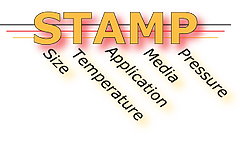Selecting the Proper Hose for Your Application
 |
The "STAMP" acronym is used to help maintenance personnel remember the most important hose attributes to consider when selecting a hose: Size, Temperature, Media and Pressure. Sometimes the "STAMPED" acronym is used. The last two letters stand for Environmental factors and Delivery. |
Size
The hose I.D. must be sized accurately to obtain the proper flow velocity. A flow that’s too slow results in sluggish system performance and a flow that’s too high causes excessive pressure drops, system damage, and leaks. Use the Flow Capacity Nomogram to determine the proper hose I.D. for your application’s flow rate requirements.
The fluid power industry uses a system of measurement called Dash Numbers or Dash Sizes to identify hose and fitting size. The Dash Number is the measure of a hose’s Inner Diameter (I.D.) in sixteenths of an inch. (See the chart on the Dash Number page for complete details and exceptions.)
To find out the hose size, check the layline. If the original printing has worn off, the original hose must be cut and the inside diameter measured. Be sure to measure the overall assembly length and fitting orientation before cutting the hose.
Temperature
Both media temperature (the temperature of the media conveyed through the hose) and the ambient temperature (the temperature around the hose where it is being used) need to be considered when selecting the hose. Make sure that temperature rating of the hose you are considering meets or exceeds the higher of the media or ambient temperature of your application.
Also, make sure you consider media type along with media temperature because different fluids can increase or decrease the effects of temperature on the hose. That is why Parker hoses carry different temperature ratings for different fluids. For example, 811HT hose has a temperature range of -40°F to +257°F for petroleum-based hydraulic fluids. For water, water/glycol, and water/oil emulsion hydraulic fluids the maximum working temperature drops to +185°F and for air, the rating drops to +158°F. Always check hose specification for temperature ratings.
Application
Before selecting a hose, it is important to consider how the hose assembly will be used. Answering the following questions may help:
- What type of equipment is the hose going to be used on?
- What environmental factors will the hose be exposed to?
- Are mechanical loads applied to the assembly?
- Will the routing be confined?
- Is there a need to use field attachable fittings?
- Will the assembly be subjected to abrasion?
Specific applications often require specific hoses. For example, applications where hoses will encounter rubbing or abrasive surfaces would best be handled by Parker's family of abrasion-resistant hoses with either Tough or Super Tough covers.*
When application space is tight, bend radius is another important consideration. Parker offers a full line of hoses designed for one-half SAE bend radius at full SAE-rated pressures. Our Compact™ hoses’ increased flexibility and smaller outer diameter allows faster and easier routing in small spaces.
Industry standards set specific requirements concerning construction type, size, tolerances, burst pressure, and impulse cycles of hoses. Parker hydraulic hoses meet or exceed standards such as:
- SAE (Society of Automotive Engineers)
- EN (European Norm)
- DIN (Deutsche Institute fur Normung)
- ISO (International for Standardization Organization)
* Results from the ISO 6945 metal-to-hose abrasion test show that Parker Tough and Super Tough cover hoses offer significantly greater abrasion resistance than standard rubber cover hose. Tough Cover provides up to 80 times greater protection and Super Tough Cover provides up to 450 times greater protection against abrasion.
Media
The hose you order must be compatible with the medium being conveyed. Compatibility must cover not just the inner tube, but the cover, hose fittings, and o-rings as well. Use the Chemical Resistance Chart to select the correct components of the hose assembly that will be compatible with your system’s media. The chart contains the chemical resistance rating of a variety of hose materials with many commonly used fluids and chemicals.
Pressure
It is important to know both the system working pressure and any surge pressures and spikes. Select a hose with the published maximum working pressure equal to or greater than the maximum system pressure AND any surge pressures or peak transient pressures in the system. Pressure ratings for the most common Parker hoses can be found on the Hose Overview Chart.
All Parker hydraulic hoses have passed the industry rated specifications 4:1 design factor unless otherwise noted. Burst pressure ratings for hose are for manufacturing test purposes only. They are not an indication that the product can be used above the published maximum working pressure.
When selecting components of a hose assembly, you must look at the “weakest link” of the assembly. A hose assembly is rated at the maximum working pressure of its component with the lowest pressure rating.
Here is an example: An F471TC0101040404-60" hose assembly (which consists of 471TC-4 hose and two 10143-4-4 fittings) would have a maximum working pressure of the lesser of the three components. In this case the fittings have a 12,000 psi rating. The hose has a 5,800 psi rating. Therefore the maximum pressure rating of the hose assembly would be 5,800 psi. Pressure ratings for each Parker end connection can be found on the Pressure Rating of Hose End Connections.
For more information, please see Parker Safety Guide 4400-B.1 for selecting and using hose, tubing, fittings and related accessories.

